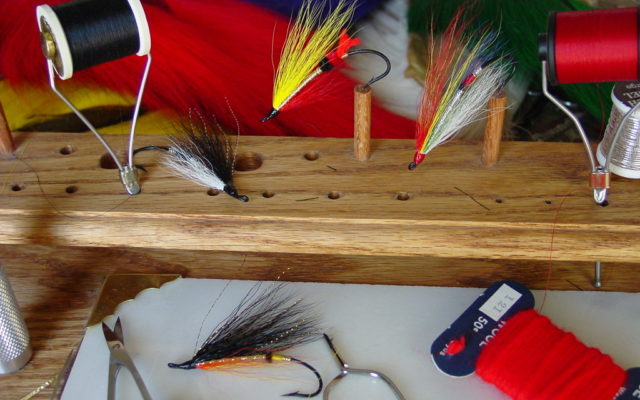While April 1 may well be the opening day of open water fishing season, finding any fishable, ice free pools might just be the April Fools trick of the day. There’s still plenty of snow and frigid weather to endure, so I’m looking ahead to May and ice out trolling on Aroostook lakes. Dragging tandem streamer flies near the surface of recently ice free lakes and ponds offers some of the largest trout and salmon and most consistent action of the year.
The key to success is selecting the right tandem streamer; every angler has a favorite fly and it’s only logical that it’s the one you use the most. Any streamer that’s in the water most of the time you’re trolling is bound to catch the most fish, but that doesn’t mean there’s not another fly that will catch more and larger trout and salmon. Water temperature and clarity, air temperature, wind speed and direction and trolling speed and depth all affect success, and all change regularly during the ice out conditions.

A red and white bucktail streamer is one of Bill Grave’s favorite ice out trolling streamers, and it really works as this stringer proves. (Bill Graves photo)
Changing color and style of trolling flies is the true foundation of consistent action for spring fishing. First off, it’s important to understand that there are two basic styles of tandem streamers — an imitator and an attractor. Imitators resemble in color and shape a smelt or one of several species of minnows that game fish feed on in a particular waterway. Attractor flies use vivid colors and flash to draw attention and elicit strikes based on aggression since most don’t look like any real and live food source. Both can be very productive depending on current water, weather, and bait conditions.
To add a bit more clarity to the complex choice of the best tandem streamer, the material used to construct an attractor or imitator must be considered. The big question here is whether a feather wing pattern or a hair wing pattern yields more realism as it swims behind the boat. One of the most difficult lessons every angler must learn is that flies which are very attractive to a fisherman may not be at all provocative to a fish. Experience and experimentation are the best teachers over time.
Feather wing streamers have a special flow and undulation as they glide through the water; they offer a very similar look to swimming bait fish. Hair and bucktail wings offer a very different motion, the fibers expand and compress with a very lifelike breathing action when the fly darts and weaves in the current. There’s no steadfast rule to guide fishermen, but on certain days one style will really outperform the other, so it’s always good to alternate patterns.
Many years ago I developed my own style of dropper line rig that allows me to actually troll two tandem streamers from one rod. I use a three-way swivel attached to my level trolling line or my fly line, with an 8 foot and 12 foot leader tied to the other two eyes. I crimp a split shot sinker the size of a pencil eraser about 18- to 24-inches from the end of the short leader. With this dual system I can not only troll an imitator and an attractor streamer, but have each at a different depth.
If it becomes apparent after a few strikes that fish are hitting on one style more than the other, I can tie on two of the preferred flies. I can also offer a feather wing and a hair wing streamer and see if one outperforms the other. I’ve found that when water clarity is compromised as it often is during ice out trolling, the brightly colored patterns show up better and draw more hits. As the lakes turn over and clear, and smelts begin to run, bait fish imitator flies are the way to go.

A red and white bucktail streamer is one of Bill Grave’s favorite for ice out trolling and it really works. (Bill Graves photo)
If I had to pick only a dozen tandem streamer patterns for the rest of my fishing days, I’d go with six each of the bucktail and feather wing. Then I’d split those with three each of the imitator and attractor styles. To this selection, I’d make sure as many as possible were tied with real jungle cock feathers for cheeks, it really does make a difference.
For feather wing imitators I’d select a gray ghost, supervisor and a Jasbo, and for hair wing, the trio would be a Magog smelt, black nose dace, and Jock Scott bucktail. Colorful attractors include Ouananiche Sunset, Morning Glory and Colonel Bates, while a Red and White bucktail, Mickey Finn and Herb Johnson special fill the bill for hair wings. Just as a side note, you would be amazed how many tandem streamers have wings comprised of both feathers and bucktail. I always have a couple of these on hand as well.
With spring on the horizon, it’s time to sit down at your fly tying bench or at least visit the local rod and gun shop to stock up, Variety is the basis of regular success for early trolling. Change is good. Give some new patterns a try.
- These streamer flies worked well on brook trout last spring. (Bill Graves photo)





